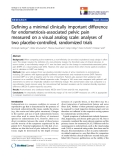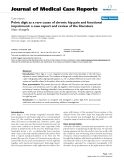
Pelvic pain
-
Tuyển tập báo cáo các nghiên cứu khoa học quốc tế ngành y học dành cho các bạn tham khảo đề tài: Quality of life associated to chronic pelvic pain is independent of endometriosis diagnosis-a crosssectional survey
 5p
5p  panasonic05
panasonic05
 23-12-2011
23-12-2011
 50
50
 3
3
 Download
Download
-
Tuyển tập báo cáo các nghiên cứu khoa học quốc tế ngành y học dành cho các bạn tham khảo đề tài: Defining a minimal clinically important difference for endometriosis-associated pelvic pain measured on a visual analog scale: analyses of two placebo-controlled, randomized trials
 7p
7p  panasonic05
panasonic05
 23-12-2011
23-12-2011
 60
60
 3
3
 Download
Download
-
Tuyển tập báo cáo các nghiên cứu khoa học quốc tế ngành y học dành cho các bạn tham khảo đề tài: Pelvic digit as a rare cause of chronic hip pain and functional impairment: a case report and review of the literature
 3p
3p  thulanh30
thulanh30
 19-12-2011
19-12-2011
 51
51
 3
3
 Download
Download
-
The biggest factor in back and hip pain is frequently the psoas muscle. Many believe the psoas muscle is one of the most important muscles in the body. The number of problems caused by the psoas is quite astonishing. These include: low back pain, sacroiliac pain, sciatica, disc problems, spondylolysis, scoliosis, hip degeneration, knee pain, menstruation pain, infertility, and digestive problems. The list can also include biomechanical problems like pelvic tilt, leg length discrepancies, kyphosis, and lumbar lordosis. ...
 4p
4p  truongthiuyen2
truongthiuyen2
 10-06-2011
10-06-2011
 72
72
 3
3
 Download
Download
-
Do you experience pain or cramps between periods? If you do, you may be experiencing Mittelschmerz. Mittelschmerz is pelvic pain and cramps that occur during ovulation in some women. The word Mittelschmerz originates from Germany and translated means "middle pain." You may hear Mittelschmerz called various terms including painful ovulation, mid-cycle pain, and middle cramps or pain. Ovulation normally occurs about two weeks after the first day of menstruation. During ovulation, one of the ovaries releases an ovum, or egg, into the corresponding fallopian tube.
 3p
3p  truongthiuyen2
truongthiuyen2
 10-06-2011
10-06-2011
 65
65
 3
3
 Download
Download
-
Chondrosarcoma Chondrosarcoma, which constitutes ~20–25% of all bone sarcomas, is a tumor of adulthood and old age with a peak incidence in the fourth to sixth decades of life. It has a predilection for the flat bones, especially the shoulder and pelvic girdles, but can also affect the diaphyseal portions of long bones. Chondrosarcomas can arise de novo or as a malignant transformation of an enchondroma or, rarely, of the cartilaginous cap of an osteochondroma. Chondrosarcomas have an indolent natural history and typically present as pain and swelling.
 5p
5p  konheokonmummim
konheokonmummim
 03-12-2010
03-12-2010
 69
69
 4
4
 Download
Download
-
Clinical Presentation and Staging Patients with cervix cancer generally are asymptomatic, and the disease is detected on routine pelvic examination. Others present with abnormal bleeding or postcoital spotting that may increase to intermenstrual or prominent menstrual bleeding. Yellowish vaginal discharge, lumbosacral back pain, lower-extremity edema, and urinary symptoms may be present. The staging of cervical carcinoma is clinical and generally completed with a pelvic examination under anesthesia with cystoscopy and proctoscopy.
 5p
5p  konheokonmummim
konheokonmummim
 03-12-2010
03-12-2010
 85
85
 5
5
 Download
Download
-
Malignant germ cell tumors are usually large (median—16 cm). Bilateral disease is rare except in dysgerminoma (10–15% bilaterality). Abdominal or pelvic pain in young women is the usual presenting symptom. Serum human chorionic gonadotropin (β-hCG) and α fetoprotein levels are useful in the diagnosis and management of these patients. Before the advent of chemotherapy, extensive surgery was routine, but it has now been replaced by careful evaluation of extent of spread, followed by resection of bulky disease and preservation of one ovary, the uterus, and the cervix, if feasible.
 5p
5p  konheokonmummim
konheokonmummim
 03-12-2010
03-12-2010
 80
80
 5
5
 Download
Download
-
Polycystic Ovarian Syndrome: Treatment The major abnormality in patients with PCOS is the failure of regular, predictable ovulation. Thus, these patients are at risk for the development of dysfunctional bleeding and endometrial hyperplasia associated with unopposed estrogen exposure. Endometrial protection can be achieved with the use of oral contraceptives or progestins (medroxyprogesterone acetate, 5–10 mg, or prometrium, 200 mg daily for 10–14 days of each month).
 5p
5p  konheokonmummim
konheokonmummim
 30-11-2010
30-11-2010
 65
65
 4
4
 Download
Download
-
Acute Pelvic Pain: Treatment Treatment of acute pelvic pain depends on the suspected etiology but may require surgical or gynecologic intervention. Conservative management is an important consideration for ovarian cysts, if torsion is not suspected, to avoid unnecessary pelvic surgery and the subsequent risk of infertility due to adhesions. The majority of unruptured ectopic pregnancies are now treated with methotrexate, which is effective in 84–96% of cases. However, surgical treatment may be required.
 5p
5p  konheokonmummim
konheokonmummim
 30-11-2010
30-11-2010
 84
84
 4
4
 Download
Download
-
Harrison's Internal Medicine Chapter 51. Menstrual Disorders and Pelvic Pain Menstrual Disorders and Pelvic Pain: Introduction Menstrual dysfunction can signal an underlying abnormality that may have long-term health consequences. Although frequent or prolonged bleeding usually prompts a woman to seek medical attention, infrequent or absent bleeding may seem less troubling, and the patient may not bring it to the attention of the physician. Thus, a focused menstrual history is a critical part of every female patient encounter.
 5p
5p  konheokonmummim
konheokonmummim
 30-11-2010
30-11-2010
 79
79
 4
4
 Download
Download
-
Role of the hypothalamic-pituitary-gonadal axis in the etiology of amenorrhea. Gonadotropin-releasing hormone (GnRH) secretion from the hypothalamus stimulates follicle-stimulating hormone (FSH) and luteinizing hormone (LH) secretion from the pituitary to induce ovarian folliculogenesis and steroidogenesis. Ovarian secretion of estradiol and progesterone controls the shedding of the endometrium, resulting in menses and, in combination with the inhibins, provides feedback regulation of the hypothalamus and pituitary to control secretion of FSH and LH.
 5p
5p  konheokonmummim
konheokonmummim
 30-11-2010
30-11-2010
 89
89
 4
4
 Download
Download
-
Algorithm for evaluation of amenorrhea. β-hCG, human chorionic gonadotropin; PRL, prolactin; FSH, follicle-stimulating hormone; TSH, thyroidstimulating hormone. Hypogonadotropic Hypogonadism Low estrogen levels in combination with normal or low levels of LH and FSH are seen with anatomic, genetic, or functional abnormalities that interfere with hypothalamic GnRH secretion or normal pituitary responsiveness to GnRH. Although relatively uncommon, tumors and infiltrative diseases should be considered in the differential diagnosis of hypogonadotropic hypogonadism (Chap. 333).
 5p
5p  konheokonmummim
konheokonmummim
 30-11-2010
30-11-2010
 72
72
 4
4
 Download
Download
-
ANORECTAL AND PELVIC FLOOR TESTS Pelvic floor dysfunction is suggested by the inability to evacuate the rectum, a feeling of persistent rectal fullness, rectal pain, the need to extract stool from the rectum digitally, application of pressure on the posterior wall of the vagina, support of the perineum during straining, and excessive straining. These significant symptoms should be contrasted with the sense of incomplete rectal evacuation, which is common in IBS.
 5p
5p  ongxaemnumber1
ongxaemnumber1
 29-11-2010
29-11-2010
 70
70
 5
5
 Download
Download
-
Neuromuscular Disease Patients with neuromuscular disease often have an abnormal gait, occasionally as a presenting feature. With distal weakness (peripheral neuropathy) the step height is increased to compensate for foot drop, and the sole of the foot may slap on the floor during weight acceptance. Neuropathy may be associated with a degree of sensory imbalance, as described above. Patients with myopathy or muscular dystrophy more typically exhibit proximal weakness. Weakness of the hip girdle may result in a degree of excess pelvic sway during locomotion.
 5p
5p  ongxaemnumber1
ongxaemnumber1
 29-11-2010
29-11-2010
 74
74
 3
3
 Download
Download
-
Referred Pain from Visceral Disease Diseases of the thorax, abdomen, or pelvis may refer pain to the posterior portion of the spinal segment that innervates the diseased organ. Occasionally, back pain may be the first and only manifestation. Upper abdominal diseases generally refer pain to the lower thoracic or upper lumbar region (eighth thoracic to the first and second lumbar vertebrae), lower abdominal diseases to the midlumbar region (second to fourth lumbar vertebrae), and pelvic diseases to the sacral region.
 4p
4p  ongxaemnumber1
ongxaemnumber1
 26-11-2010
26-11-2010
 74
74
 5
5
 Download
Download
CHỦ ĐỀ BẠN MUỐN TÌM




























